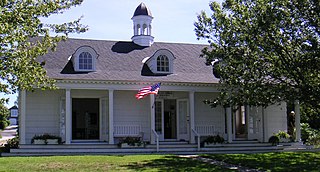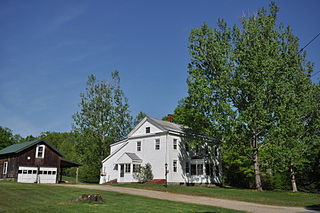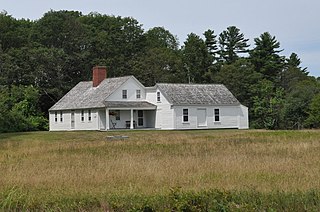
Bailey Island Library Hall is a historic community building at 2167 Harpswell Island Road, on Bailey Island in Harpswell, Maine. Built in 1911–12, it has been a center of community life on the island since its construction, and is a notable architectural work of the New York City architectural firm Mann & MacNeille. Originally built to house a lending library and social hall, it now only serves the latter function. It was listed on the National Register of Historic Places on December 31, 2008.

The Wales and Hamblen Building is a historic commercial building at 260 Main Street in Bridgton, Maine. Built in 1882, it is a fine example of late Italianate architecture, and one of the town's most architecturally sophisticated commercial buildings. It was listed on the National Register of Historic Places.

The Harpswell Meetinghouse is a historic colonial meeting house on Maine State Route 123 in Harpswell, Maine. Built in 1757-59 to provide space for both religious services and town meetings, it is a little-altered and well-preserved example of a once-common form, and is the oldest such surviving building in the state of Maine. It was designated a National Historic Landmark in 1968.

The Sibley–Corcoran House is a historic house at 387 Upper Valley Road in Washington, Massachusetts. Built about 1813, it is a well-preserved example of a rural Federal style farmhouse, with later Greek Revival alterations. The house was listed on the National Register of Historic Places on September 12, 1986.

The First Congregational Church and Parsonage is a historic church complex at 23 Pepperrell Road in the Kittery Point section of Kittery, Maine. Built in 1730 for a congregation first organized in 1653, the church is the oldest in Kittery, and one of the oldest in the state of Maine. It is accompanied by a parsonage house, built in 1729, and a small cemetery, established in 1733. The buildings were listed on the National Register of Historic Places in 1978; the cemetery was added to the listing in 1997.

The East Harpswell Free Will Baptist Church is a historic church on Cundys Harbor Road in East Harpswell, Maine. Built in 1843, it is a little-altered modest Greek Revival structure, with a reversed interior layout that is now extremely rare within the state. It has been used only sporadically since the early 20th century, but is maintained by a local community group. The building was listed on the National Register of Historic Places in 1988.

The Elijah Kellogg Church is a historic Congregationalist church at 917 Harpswell Neck Road in Harpswell, Maine. Built in 1843, it is a well-preserved example of Greek and Gothic Revival architecture, and is further notable for its longtime association with Rev. Elijah Kellogg, a well-known 19th-century writer of children's books. The church building was listed on the National Register of Historic Places in 1979. The church is affiliated with the National Association of Congregational Christian Churches; its pastor is John Carson.

Oakfield Station is a historic former passenger rail station on Station Street in Oakfield, Maine. The station was built in 1911 by the Bangor and Aroostook Railroad, and is a major reminder of Oakfield's onetime importance as a railroad center. The station is home to the Oakfield Railroad Museum which is operated by the Oakfield Historical Society. It was listed on the National Register of Historic Places on June 25, 1987.

The Bell Hill School or District Number One School is an historic school in Otisfield, Maine. The one-room brick schoolhouse was one of three completed in 1839 for the town, and is the only one to survive. It served the town as a district school until 1940. It was acquired in 1950 by the Bell Hill Meetinghouse Association, and has been converted into a local history museum. The building was listed on the National Register of Historic Places in 2003.

The Tarr–Eaton House is an historic house at 906 Harpswell Neck Road in Harpswell, Maine. Built before 1783 and enlarged about 1840, it is a well-preserved 18th-century Cape with added Greek Revival features, and one of Harpswell's few surviving pre-Revolutionary War buildings. It was listed on the National Register of Historic Places in 2001.

The Elijah Kellogg House is an historic house on Barton Lane in Harpswell, Maine. It is a well-preserved Greek Revival house, built in 1849 by Elijah Kellogg, a Congregationalist minister at the nearby church, and a lecturer and author of popular boy's adventure books. The house was listed on the National Register of Historic Places on April 28, 1975.

The John G. Coburn Farm is a historic farmstead at 434 Carthage Road in Carthage, Maine. The farmhouse, a two-story brick structure built in 1824, stands on the west side of the road just north of its crossing of the Webb River. The house is regionally distinctive as the only brick building in the Webb River valley. The farm, which now includes 29 acres (12 ha), also includes two English barns, one of which has been dated to the early 19th century. The farm was listed on the National Register of Historic Places in 2002.

The Former Fryeburg Town House is a historic municipal building in what is now a rural section of Fryeburg, Maine. Built in 1847, it served as Fryeburg's town hall for over 130 years, and is still used as a polling place. It was listed on the National Register of Historic Places in 1992.
The Hancock Point School is a historic former school building at 644 Point Road in Hancock, Maine. Built c. 1870, this wood frame one-room schoolhouse served as a school until 1940, and is now privately owned. It is the town's only surviving district schoolhouse, and was listed on the National Register of Historic Places in 2013.

The Samuel Holden House is a historic house, now located on the grounds of the Moose River Golf Club on United States Route 201 in Moose River, Maine. This 1+1⁄2-story Cape style house was built in 1829 by Samuel Holden (1772-1858), the first white settler of the region, and is the oldest known house standing on the "Canada Road", built around that time to join central Maine to Quebec. The house was listed on the National Register of Historic Places in 1995.
The Larsson–Noak Historic District encompasses a collection of buildings constructed by Swedish immigrants to northern Maine between about 1888 and 1930. The district is focused on a cluster of four buildings on Station Road, northeast of the center of New Sweden, Maine. Notable among these is the c. 1888 Larsson-Ostlund House, which is the only known two-story log house built using Swedish construction techniques in the state. Across the street is the c. 1900 Noak Blacksmith Shop, a virtually unaltered building housing original equipment. The district was listed on the National Register of Historic Places in 1989.

The Barrell Homestead is a historic house at 71 Beech Ridge Road in York, Maine, United States. At the core of this three-story house is a c. 1720 late First Period house, which has been in the hands of a single family since 1758. It was home to one of York's most colorful residents of the second half of the 18th century, Nathaniel Barrell. The house was listed on the National Register of Historic Places in 1976.
The District No. 5 School House is a historic school building on Billings Road at School House Lane in Hermon, Maine. Probably built about 1880, it is the rural community's best-preserved one-room schoolhouse, and is now maintained by the local historical society. It was listed on the National Register of Historic Places in 1997.

The Mill Cove School, also known as the Littlefield School House, is a historic school building on Berrys Mill Road in West Bath, Maine. Built about 1853, it is the town's last surviving unaltered district school house. It underwent restoration in the early 2000s, and was listed on the National Register of Historic Places in 2000.

The District No. 5 Schoolhouse is a historic district school building at 32 Pleasant Valley Road in Underhill, Vermont. Built in 1861, it served the town as a school until it was damaged by fire in 1951, but remains a community landmark. It is now owned by the local historical society. It was listed on the National Register of Historic Places in 2018.



















